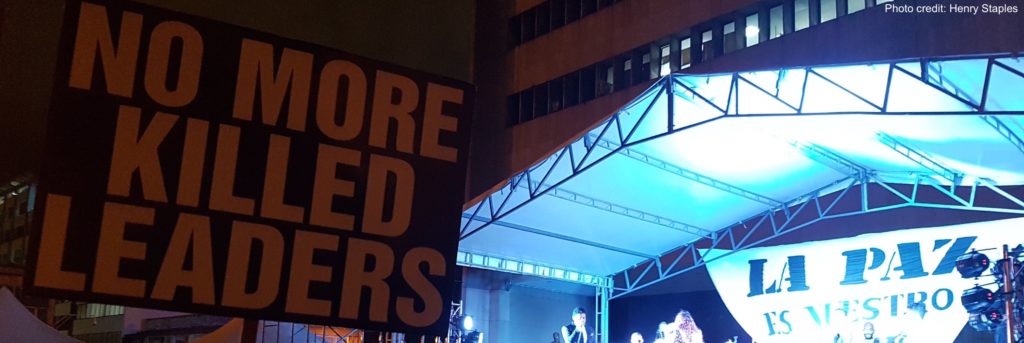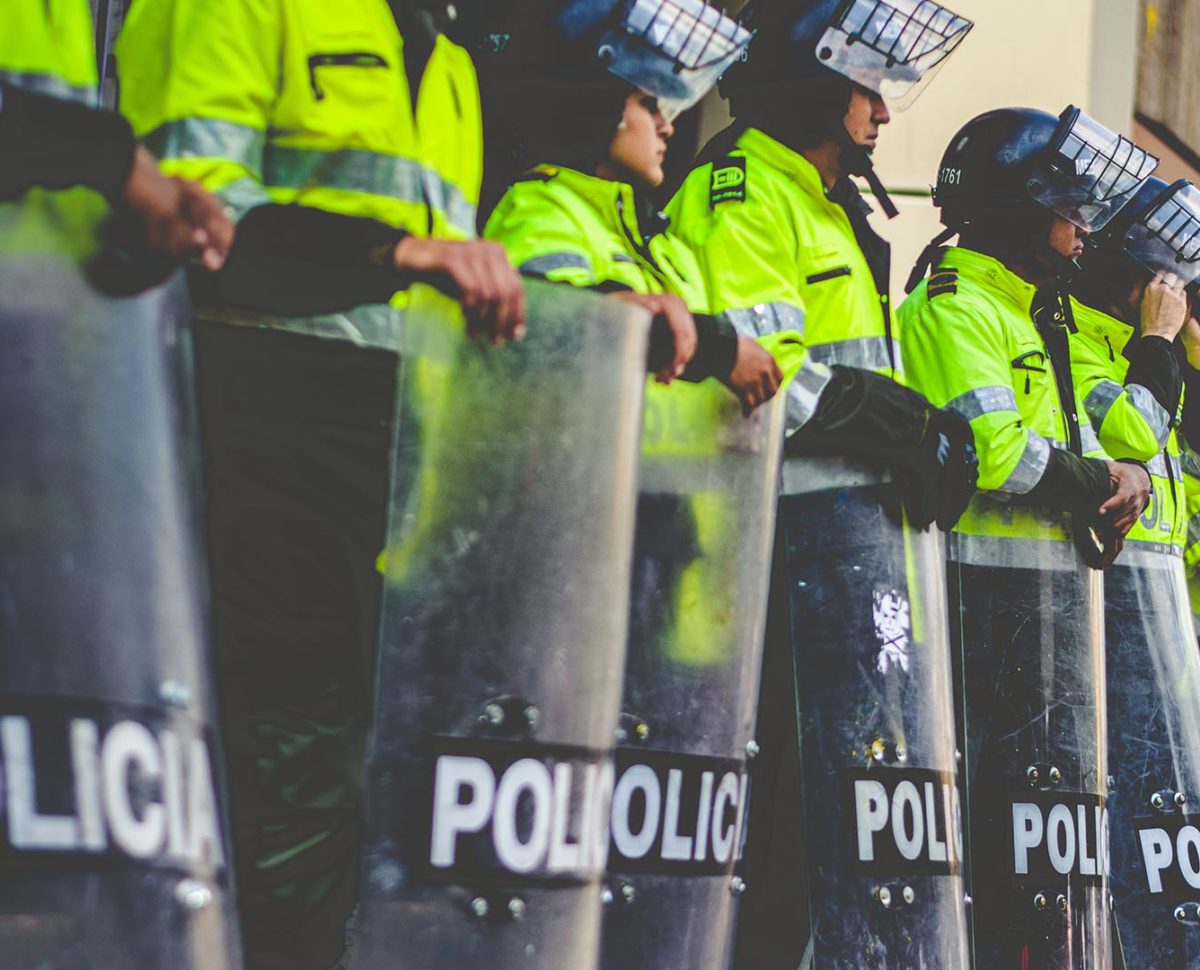
Dr Henry Staples
‘The most enduring impact of a peace process on civil war may not reside in the agreement, but in the social and political energies inadvertently awakened through the process. This is an urgent hypothesis which the international comparative perspective informing the Civil War Paths project can illuminate…’
Peace from below
If peace processes are the means by which a country transitions out of conflict, they are central to understanding the paths which civil wars follow. Recent years have seen a participatory surge within and around negotiations, often drawing on broader waves of social mobilisation. In this piece, I put forward some ideas from my research on Colombia’s peace process to ask: what can we learn at the intersection of peace and contentious politics?
Over the last 30 years, the United Nations has adjusted its focus from interstate to intrastate conflicts, and moved from a ‘peacekeeping’ to a ‘peacebuilding’ approach. While the former prioritised ending overt hostilities, the latter considered structural conditions including the maldistribution of land and resources, internal displacement, and state fragility: a complex set of challenges demanding a more long-term and integrated response.
Inspired by John Paul Lederach’s idea of ‘peace from below’, many researchers have since rejected this top-down model for disregarding cultural differences within and between countries. The ‘local turn’ also questions the liberal assumptions implicit within UN peacebuilding, including the prioritisation of economic above environmental concerns, and the emphasis on holding swift post-conflict elections. Local turn advocates note that if agreements succeed in ending conflict, they often struggle to realise even their own goals.
This emphasis on inclusivity has influenced policymaking (see the UN’s new Sustaining Peace approach) and contributed to a surge in diverse forms of collective action during peace negotiations. This warrants research into the dynamics and relative effectiveness of different modes of participation, including their capacity to drive a more robust and equitable path forward.
Here I focus on negotiations between the Colombian Government and the Revolutionary Armed Forces of Colombia (FARC) guerrilla group, which culminated in the widely lauded Final Agreement to End the Armed Conflict and Build a Stable and Lasting Peace. Building on Michael Livesey’s discussion of ‘discursive tracks’, I argue that despite highly divergent accounts of the causes of conflict, the concept of ‘territorial peace’ provided the basis for inviting communities to participate in the construction of a shared agenda. Yet, as this opened new space for debate, it also awakened deep political divisions and led to national reorientation of the peace deal amidst ongoing political turmoil.
Who gives the order?
The story of territorial peace begins with Colombia’s national Government under President Santos (2010-2018). Santos served as Minister of Defence under President Uribe (2002-2010) and was widely expected to continue his predecessor’s strategy of military victory. But Santos was conscious of abundant financial capital flowing to Colombia’s Latin American neighbours, and his National Development Plan affirms an ‘incomparable confidence‘ in ensuring Colombia’s future economic prosperity by attracting international investment and tourism. He therefore planned to disarm the FARC rather than defeat them; and reclaim Colombia’s peripheral territories for the state.
The FARC were not naïve about Santos’ agenda. One negotiator noted that consecutive administrations had neglected peripheral regions ‘far from the cities… now it matters, because it’s where the natural resources are’. They also criticised Santos for failing to acknowledge conflict as the manifestation of underlying structural drivers, and for downplaying state collusion with paramilitary actors. As one negotiator rhetorically asked, ‘who gives the orders?’
These disagreements spoke to a key question: whether peace is possible without addressing the structural inequalities inherent in liberal market democracy. Colombia’s civil war stems from political tensions between those favouring a strong, central state and others calling for greater regional autonomy. As such a familiar ‘state absence’ narrative has justified countless interventions in rural peripheries. Moreover, emergent internal and geopolitical forces (especially the boom in coca cultivation) have driven fierce competition for territorial dominance among multiple state and non-state actors. Against this backdrop, as FARC and others have argued, the state has not been absent, but has delegated its sovereignty to violent actors, which essentially served as an extension of liberal statehood.
An act of imagination
It seemed FARC and Government were at an impasse. But Santos was internationally minded; and Sergio Jaramillo, High Commissioner for Peace, was well-versed in bottom-up perspectives. Jaramillo criticised prior administrations’ short-minded peace-making, instead proposing a ‘differentiated’ peacebuilding approach which considered how the conflict had ‘affected some territories more than others’. Jaramillo then called on Colombians to participate in a national ‘act of imagination’ about their collective future.
Heeding the call for engagement, civil society organisations advanced their agendas via formal and informal means. Many rejected the Government’s economic programme and view of territory as a mere repository of resources, instead evoking concepts such as ‘buen vivir’ which centres on human-nature relations.
Similar ideas were expressed during more contentious acts, including in 2014 when a group of Afro-Colombian women marched from La Toma, Cauca, to the capital of Bogotá, in objection to state and non-state violence, illegal gold mining and the Government’s National Development Plan. These and other communities vocally rejected territorial peace as incorporation into decision-making; rather ‘defence of the ancestral territories’ meant drawing on their cultural heritage to resist territorial domination by state and non-state forces.
While the Government’s immediate response to protestors was often dismissive, the Final Agreement nevertheless promised a swathe of new guarantees for social movements. In response, some analysts speculated about a revival of the political system from below: if social movements were central to delivering territorial peace, they could steer Colombia down a more inclusive and democratic path. But others raised concerns that by regulating movements, the Agreement would undermine the effectiveness of protest which, by its nature, ‘is not always planned’.

A new political identity
President Santos proposed a national referendum to ratify the Final Agreement in 2013. This meant that peace was central to his 2014 re-election campaign. But former President Uribe founded the Democratic Centre to amalgamate political opponents to the deal, and their candidate attained the most votes in the first-round. Santos was narrowly victorious in the second-round and led the Yes campaign, but virulent hostility directed towards allied parties and movements showed that peace was both polarising and potentially generative of conflict. While Yes campaigners spoke of a prosperous shared future, the 2016 referendum also became a focal point for actors seeking to acquire political capital by opposing the deal. The No campaign’s surprise victory exposed deep social, political, and territorial fractures. And, while the Agreement was later modified and ratified, the 2018 presidential election gave a victory to the Democratic Centre.
President Ivan Duque’s administration has since replaced territorial peace with ‘peace with legality’ as the guiding framework for implementation, and acts of intimidation and assassination of human rights activists, perpetrated by paramilitary actors, have not abated.
Still, there is some cause for optimism. The 2019 elections suggested a strong future for independent parties. One urban activist I interviewed in the days after the vote told me that Colombians were finally searching for a ‘new political identity’ beyond the bounds of traditional politics. This view has been given greater credence since the 2019-2020 and 2021 National Strikes. During these unprecedented events, protestors drew on a wave of Latin American unrest to evoke historical grievances and indignation at delays to the peace deal, with many combining these demands with calls for profound structural change.
Concluding thoughts: a society in movement
This piece offered an overview of the contentious politics of peace negotiations in Colombia. I showed that the Santos administration employed territorial peace as a discursive track to set itself apart from prior governments. A combination of international inspiration and political expediency provided the rationale for directly incorporating communities into the process, and civil society participants engaged directly and indirectly in unprecedented numbers.
So, what does this surge in peace participation mean in the long term? Civil society unarguably infused territorial peace with culturally specific ideals, and the Final Agreement praises Colombia’s cultural diversity and calls on communities to lead in post-conflict transformation. But Government statements betrayed an underlying focus on assuring access to – and exploitation of – land for productive gain, and implementation has been mostly confined to clear pre-defined boundaries.
President Duque’s 2018 election further revealed what can happen when opposition to peace is wielded as a political tool, and implementation has slowed during his administration. These and other challenges signal that, perhaps, a lasting peace would have to begin with consultation.
Still, the most enduring impact of a peace process on civil war may not reside in the agreement, but in the social and political energies inadvertently awakened through the process. This is an urgent hypothesis which the international comparative perspective informing the Civil War Paths project can illuminate.
Here I only hint towards some insightful analysis offered by Raúl Zibechi, who argues that ‘societies in movement’, rather than social movements are the predominant drivers of structural transformation in Latin America today. With lower barriers to entry and greater capacity to respond to emergent opportunities, these loose organisational structures capable of spontaneous popular mobilisation may have set Colombia on a new path.

